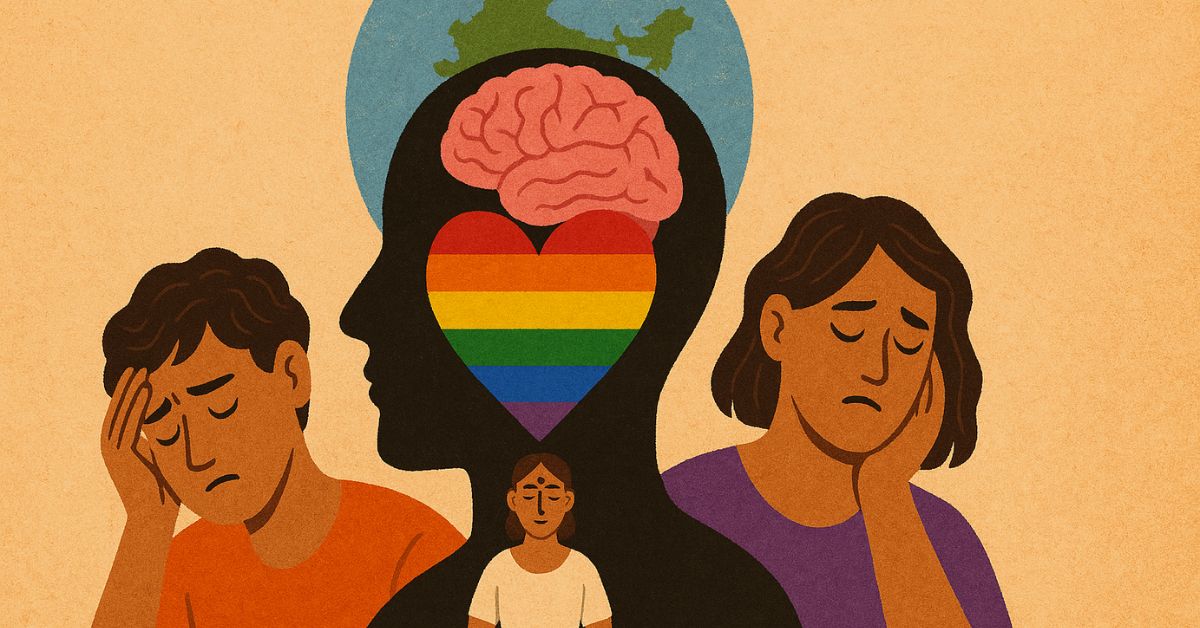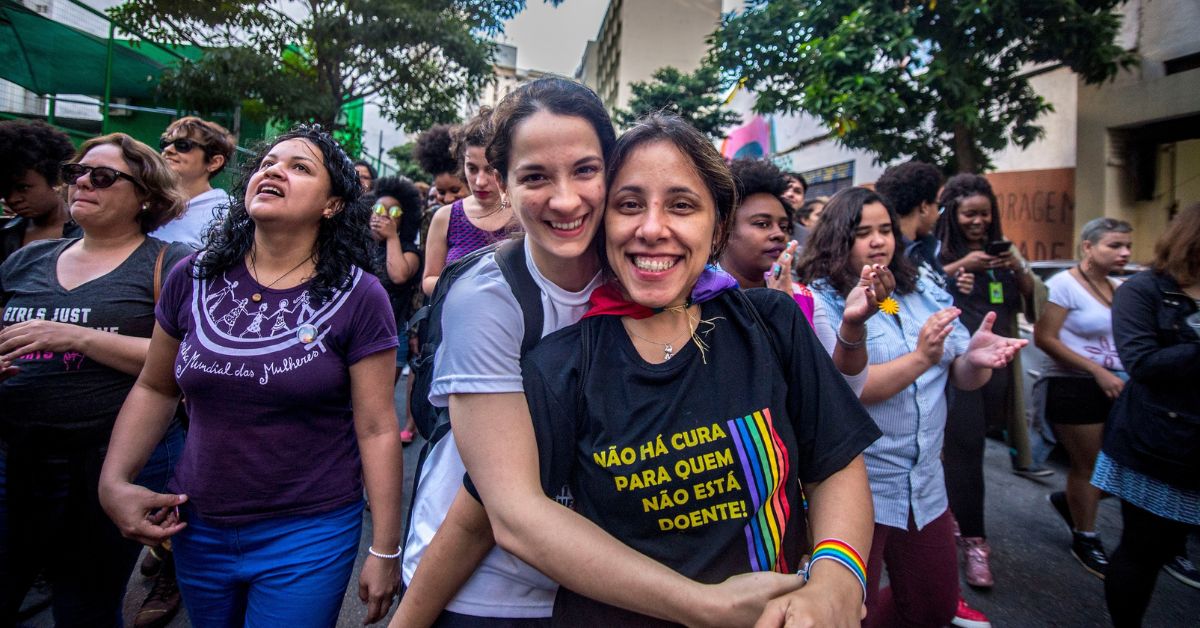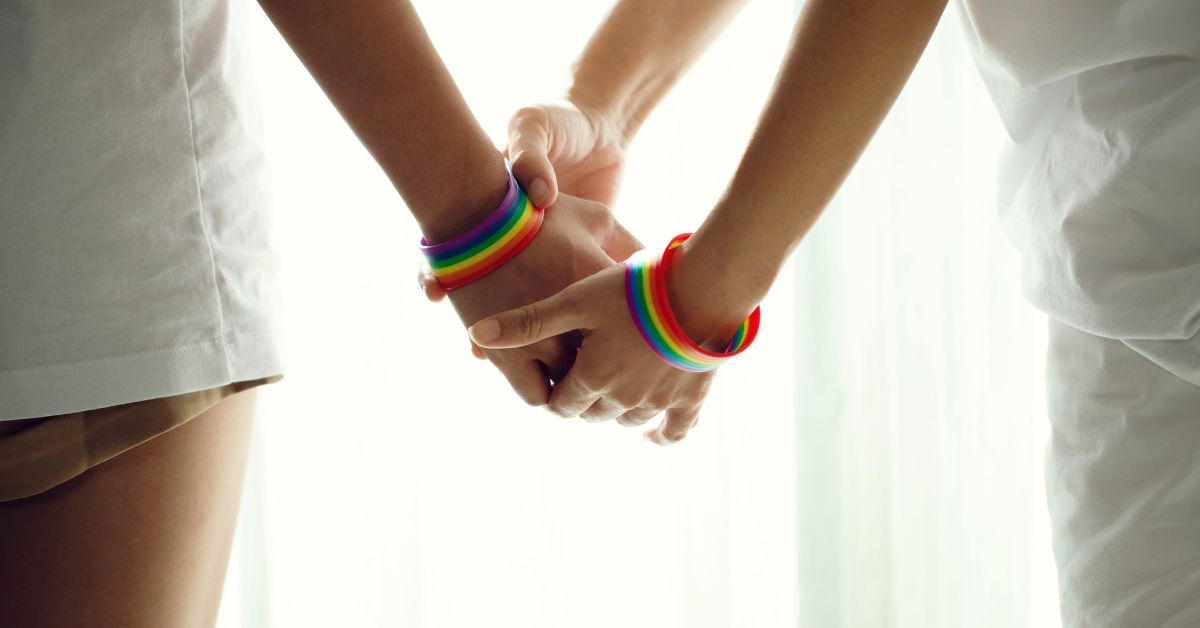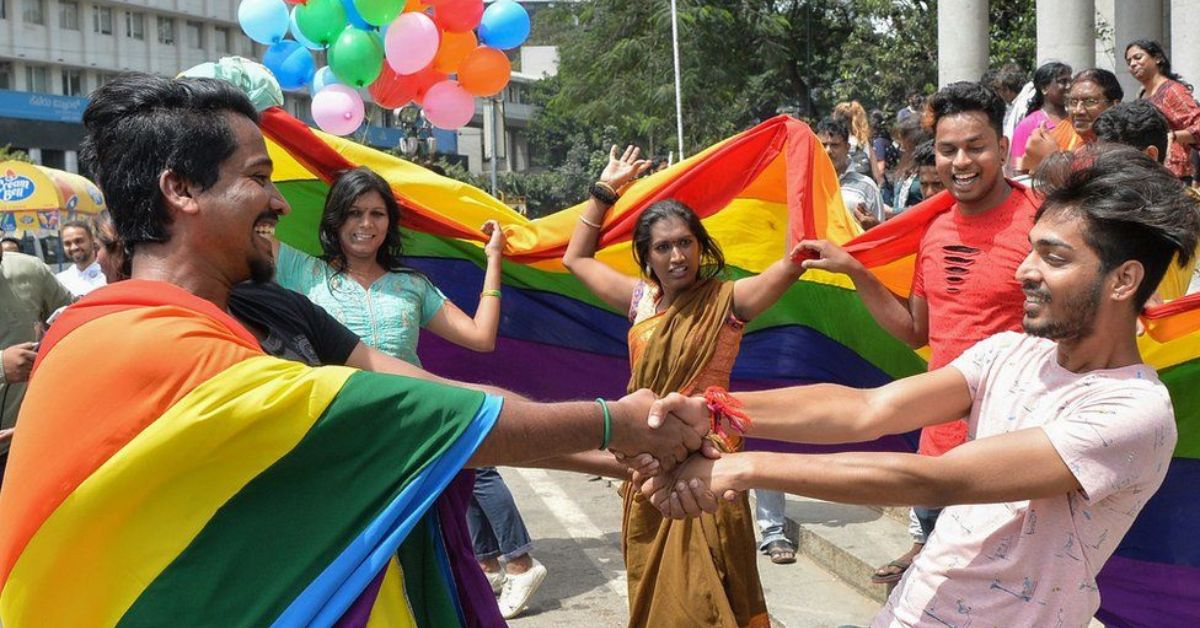‘Is My Queerness Something to Fix?’ What Therapists Want You to Know About Queer Mental Health
Some battles are not fought in public rallies or loud debates. They unfold quietly in therapy rooms, on the psychiatrist’s couch, or in long silences between family conversations. For LGBTQ+ individuals in India, navigating identity often means braving an invisible terrain where shame is inherited, validation is rare, and simply being oneself can be a daily negotiation.
The mental health struggles of LGBTQ+ individuals in India are both urgent and deeply overlooked. Recent studies paint a stark picture concerning India’s LGBTQ+ population: among individuals with same-sex partners (males), between 29 percent and 45 percent report symptoms of depression, while transgender women show even higher rates, ranging from 43 percent to 59 percent. Anxiety is just as prevalent, affecting up to 40 percent of those with same-sex partners and nearly 39 percent of transgender women.
Perhaps most alarming is the prevalence of suicidal thoughts, with almost half of those in same-sex relationships (males) experiencing them and nearly one in four attempting suicide. These aren’t just statistics — they are lived, everyday realities of people, quietly playing out behind closed doors.
Pride Month is not just about visibility and rainbow flags across social media. But it is about being able to reflect and start a conversation. What does it mean to be queer, navigating health challenges and mental distress, in a country that only recently took steps to ban conversion therapy? What does support look like when your suffering isn’t rooted in a chemical imbalance, but in the quiet and constant messaging from society that you are “too much,” or “too different?”
 The statistics show a concerning state of the mental health of LGBTQ+ individuals. Picture source: Open Global Rights
The statistics show a concerning state of the mental health of LGBTQ+ individuals. Picture source: Open Global Rights
To dig deeper, we spoke with two experts at the forefront of mental health care for queer individuals: Dr Akanksha Das, a consultant clinical psychologist at Fortis Hospital, Mulund, and Dr Sameer Bhargava, a psychiatrist at Fortis Escorts Hospital, Faridabad. Their raw, thoughtful, and at times unsettling offer a window into the private pain and public erasure that many queer Indians still face and how they try to help any individual who walks in through their door seeking a sense of acceptance or an allyship.
‘They fear that their identities will be seen as a disorder’
When queer clients first walk into therapy, it’s rarely just about a breakup, a panic attack, or trouble sleeping. There’s an added layer of caution, an emotional pre-screening that starts even before the session does.
“Queer individuals may be very cautious when entering therapy,” Dr Akanksha shares. “They fear that in session, they won’t be taken seriously or that their identities will be seen not as real, but as a mental health issue in themselves.”
Even today, despite increasing awareness, many queer clients walk into sessions wondering whether their identities will be pathologised, an echo of a medical history that labelled homosexuality as a disorder until 2018. “They might even conceal their identity in the first few sessions,” she says, “just to be accepted by the therapist.”
But perhaps what’s even more complex is how internalised homophobia and transphobia show up in therapy. “Some might say, ‘I shouldn’t feel like this,’ or even mock their own community. This often comes from deep-seated shame,” Dr Akanksha notes.
 Many queer clients walk into sessions wondering whether their identities will be pathologised. Picture source: AI-generated
Many queer clients walk into sessions wondering whether their identities will be pathologised. Picture source: AI-generated
It’s not just about acceptance from society, it’s about unlearning the narratives that society has planted within. “I help clients understand that the shame they feel isn’t theirs to carry, it’s inherited. It comes from family, religion, and the media. And it can be unlearned.”
“They often agree that their identity is a problem to be fixed”
Dr Akanksha explains that the pressure to conform can be so intense that many queer individuals may even believe their queerness is something to be “fixed.” In one particularly heart-wrenching moment, she recalls how some clients agreed, early in therapy, that their identity was “the issue”, just to avoid rejection.
The goal, she says, is not to force revelation, but to create space. “I don’t push clients to ‘come out’ in the first session. I introduce myself as a queer-affirmative therapist. I ask their preferred pronouns. I show support in language and behaviour.”
Her approach is clear: therapy should not be another arena of judgment. “I reassure them that the distress they feel often stems from societal bias and not because they are flawed or broken.”
The psychiatrist’s dilemma: When medication meets identity
But what happens when queer distress lands not in a psychologist’s chair but on a psychiatrist’s table, where diagnoses can lead to pills and, sometimes, further erasure of their identity?
Dr Sameer Bhargava points out a crucial distinction. “When working with individuals from the queer community… their response to medical treatment is often comparable to that of the general population. But their psychosocial challenges are different.”
 Therapy should not be another arena of judgment for the LGBTQ+ community.
Therapy should not be another arena of judgment for the LGBTQ+ community.
In other words, medication can address symptoms of mental health issues, but not systems that are comprised of society, norms, and preconceived notions about LGBTQ+.
There’s also the lurking danger of misuse. “Families sometimes try to use psychiatric help as a way to control or ‘normalise’ someone’s queerness,” Dr Bhargava points out with concern. But laws are catching up. “The Mental Healthcare Act, 2017, gives individuals the right to make decisions about their mental health, as long as they can do so. And conversion therapy, where emotional or physical therapy is used to “cure” or “repair” a person’s attraction to the same sex, or their gender identity and expression, is strictly prohibited.”
And yet, remnants of the past linger. “In medical school, we were taught outdated concepts like categorising ‘transvestism’ (also known as ‘cross-dressing’, where the person feels comfortable wearing clothes generally assigned to the opposite gender) as a perversion. These ideas needed to be unlearned. Unfortunately, there’s still a gap in training on queer mental health.”
So what is done to help with internalised trauma
One of the most poignant parts of both conversations was the burden of silence — the internal, invisible labor of self-monitoring that many queer individuals engage in constantly.
“One silent burden they carry is their insight into their own vulnerability,” says Dr Bhargava. “They know what parts of themselves to suppress in what situations, and that insight, though protective, can be deeply isolating.”
 From derogatory remarks to harassment, the problems faced by queer individuals are plenty. Picture source: The Hindu
From derogatory remarks to harassment, the problems faced by queer individuals are plenty. Picture source: The Hindu
Dr Akanksha echoes this. “Queer individuals are mentally and emotionally exhausted. There can be underlying anxiety, even if it doesn’t meet the criteria for a clinical diagnosis.”
She highlights that this self-censorship extends into the professional world, too. “Many queer people are the only queer person in their organisation,” she shares. “They hear derogatory remarks, face harassment, and are afraid to speak about their life outside work. They’re walking on eggshells, and therapy is the space where they can finally be their true selves.”
Therapy, of course, doesn’t end with the individual. More often than not, family is the first, and sometimes deepest, site of trauma.
“Families can be the biggest oppressors, often reflecting generational trauma,” Dr Akanksha says. “It starts with conditional love — the idea that you’ll only be accepted if you suppress yourself.”
This pressure can manifest in horrific ways. “Some are forced into marriages where their identities are hidden, causing trauma not just to themselves but also their partners,” she adds. “These wounds are passed down. Healing begins by naming them.”
Assertiveness training, boundary-making, and building chosen families become critical tools. “It helps to give them platforms, online or offline, where they feel seen. Sometimes, social media becomes a lifeline.”
Side note: Assertive training is a structured approach to helping individuals communicate more effectively by expressing their thoughts, feelings, and needs clearly, confidently, and respectfully. It is designed to strike a balance between passivity and aggression, thus, enabling people to stand up for themselves. Whether in personal relationships or professional settings, assertiveness is about being honest and direct while maintaining respect and empathy.
At its core, assertiveness training teaches people how to say “no” without guilt, express opinions without fear, handle criticism constructively, and set healthy personal and professional boundaries.
Assertiveness training is frequently incorporated into therapeutic contexts such as Cognitive Behavioural Therapy (CBT), social skills groups, and trauma recovery programmes.
On the other hand, Dr Bhargava shares the story of a patient from the queer community diagnosed with Generalised Anxiety Disorder. “During evaluation, it became clear that gender-related confusion and societal pressure in adolescence played a huge role,” he says.
Treatment involved more than just medication. “We initiated a personalised psychosocial intervention focused on tackling internalised helplessness and cognitive distortions. It was about building resilience and not erasing identity.”
 Queer mental health care isn’t a specialty, it’s a necessity of inclusive practice. Picture source: SpringerLink
Queer mental health care isn’t a specialty, it’s a necessity of inclusive practice. Picture source: SpringerLink
For him, queer mental health care isn’t a specialty, it’s a necessity of inclusive practice. “Standard care guidelines today emphasise empathetic, non-judgmental, inclusive approaches. That’s the baseline.”
Side note: Generalised Anxiety Disorder (GAD) is a mental health condition marked by excessive, persistent worry about various aspects of life such as health, work, relationships, or safety.
For queer individuals, this anxiety can be intensified by systemic discrimination, societal stigma, and internalized stressors related to their identity.
Personalised psychosocial interventions are customised mental health and support strategies that address a person’s unique psychological, emotional, social, and sometimes cultural needs. Rather than using a one-size-fits-all approach, these interventions are tailored to an individual’s specific circumstances, identity, life experiences, and challenges.
This involves introducing the individual to queer support groups and building coping skills against anxiety and suicidal thoughts through meditation and other related activities. It can also sometimes involve having open conversations in family therapy sessions.
When pride comes with a purpose
So what can be done? Dr Akanksha suggests it begins starting a conversation. Creating a safe space grounded in empathy and care whether at home, within communities, or among allies.
Spaces like The Humsafar Trust’s Sahyog Clinic are already leading the way. Beyond offering mental health support, the clinic provides holistic services ranging from nutrition guidance and care against Sexually Transmitted Infections to counselling and legal aid.
Manochikitsa Services provides online LGBTQ+ counselling with licensed psychologists, offering services in multiple languages.
The Alternative Story offers queer-affirmative, trauma-informed, and intersectional feminist mental health counselling, creating a safe and inclusive space for marginalised voices.
Pride Month is a celebration of visibility and a reminder that there’s still a long road ahead. At its core, it calls on us to accept ourselves and support others in doing the same by breaking cycles of shame and silence and embracing the continuous journey of learning, unlearning, and growing together.
Edited by Saumya Singh
News